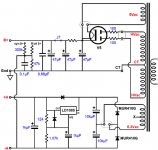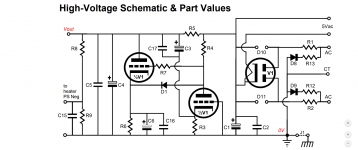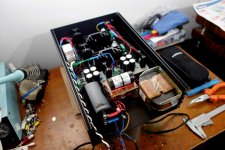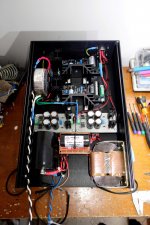Hello everyone, I'm starting to build my aikido, I bought 2 9-pin mono cards, I would like to use 4 e80cc tubes, so I should also understand and choose which power to use, one that I would choose is that simple aikido all in one, with the addition choke, or the janus shunt, which one do you think is the best choice? Or is there any other option?
Attachments
I have an Itch!! I built the old Octal In in one Aikido Linestage. has anyone seen or built the new Octal all in one design? Each channel's B+ RC filter is made up of pure polypropylene (no electrolytic) capacitance. You can also use Chokes for each channel. 😱
I’ve had a Noval pcb with the PS-1 power supply pcb sitting on my bench unpopulated for nearly two years. Need to decide on a power trafo for it and get it done as a preamp for my ACA.
Hello everyone, I'm starting to build my aikido, I bought 2 9-pin mono cards, I would like to use 4 e80cc tubes, so I should also understand and choose which power to use, one that I would choose is that simple aikido all in one, with the addition choke, or the janus shunt, which one do you think is the best choice? Or is there any other option?
I have built a 9 pin all in one with the SS PSU, and a dual mono using two Janus PSUs. They sound remarkably similar. The dual mono might have the edge, but it is more complicated and expensive, not sure it was worth the extra fuss. Both sound very nice.
Blooze:
I scratch built an Aikido noval but used the a PS-1 supply. The PS-1 has 2 small Hammond EI core trannies. A 43VA for filaments and a 25VA for HT. But I've used Triad 25VA toroids from Mouser successfully on other builds.
At first I had the B+ set for 300 volts and a tube set of all 6CG7s. It sounded too tubey and slow in the bass for my tastes. Changed the B+ over to about 170 volts, left the input tube as a 6CG7 but changed the output over to a 6DJ8. Better but wasn't really happy with the pace and drive until I changed the input tubes over to 6DJ8s as well.
Steve
I scratch built an Aikido noval but used the a PS-1 supply. The PS-1 has 2 small Hammond EI core trannies. A 43VA for filaments and a 25VA for HT. But I've used Triad 25VA toroids from Mouser successfully on other builds.
At first I had the B+ set for 300 volts and a tube set of all 6CG7s. It sounded too tubey and slow in the bass for my tastes. Changed the B+ over to about 170 volts, left the input tube as a 6CG7 but changed the output over to a 6DJ8. Better but wasn't really happy with the pace and drive until I changed the input tubes over to 6DJ8s as well.
Steve
ALERT - NEW AIKIDO TOPIC
OK, so I built the Aikido all in one Noval - with 6N1P on front end and 6H30 on back years ago - sounds nice!...
But something has always annoyed me - I hooked up the Hammond tranny (way overkill, but all I had when I built it) and have the 6.3v - 6.3v secondaries for heaters to the Aikido and after its regulation, the heaters are only seeing 5vdc. The losses in regulation circuit drop the heater voltage (duh) - and when I re-read the instructions it recommended 7v - 7v+ secondaries for the heaters, so the regulation can drop to somewhere around 6vdc.
I know Broskie proclaims 5vdc is sonicly ok and will lead to longer tube life...but know many disagree...and I wonder if I should just plop in another transformer, or just pull the regulation transistor for the heater circuit...
I cant be the ONLY ONE that has seen this issue....right?
Soooo....Could / Should this Aikido sound better with a full 6.3v on heaters?
Thanks!!!
OK, so I built the Aikido all in one Noval - with 6N1P on front end and 6H30 on back years ago - sounds nice!...
But something has always annoyed me - I hooked up the Hammond tranny (way overkill, but all I had when I built it) and have the 6.3v - 6.3v secondaries for heaters to the Aikido and after its regulation, the heaters are only seeing 5vdc. The losses in regulation circuit drop the heater voltage (duh) - and when I re-read the instructions it recommended 7v - 7v+ secondaries for the heaters, so the regulation can drop to somewhere around 6vdc.
I know Broskie proclaims 5vdc is sonicly ok and will lead to longer tube life...but know many disagree...and I wonder if I should just plop in another transformer, or just pull the regulation transistor for the heater circuit...
I cant be the ONLY ONE that has seen this issue....right?
Soooo....Could / Should this Aikido sound better with a full 6.3v on heaters?
Thanks!!!
Last edited:
Tough to say. I like to run a little under 6.3, 5.9 to 6.1 Try bypassing the regulator but be prepared to put a low ohm, high watt resistor in the fil + line to keep the voltage within bounds.
Steve
Steve
Blooze:
I scratch built an Aikido noval but used the a PS-1 supply. The PS-1 has 2 small Hammond EI core trannies. A 43VA for filaments and a 25VA for HT. But I've used Triad 25VA toroids from Mouser successfully on other builds.
At first I had the B+ set for 300 volts and a tube set of all 6CG7s. It sounded too tubey and slow in the bass for my tastes. Changed the B+ over to about 170 volts, left the input tube as a 6CG7 but changed the output over to a 6DJ8. Better but wasn't really happy with the pace and drive until I changed the input tubes over to 6DJ8s as well.
Steve
I believe I was looking at the Antek AS-2T230 or AS-1T230 at one point, but I’ll have to dig out my notes.
Blooze,
The Anteks are a good price (in the US, shipping is a bit of a killer to Canada). The advantage of the Hammonds and Triads are the dual 115 volt secondaries. In series you get a little over 300 volts raw DC after the rectifier, in parallel about 170. So if you switch over tubes like I did (see above) a different B+ trannie isn't needed.
Steve
The Anteks are a good price (in the US, shipping is a bit of a killer to Canada). The advantage of the Hammonds and Triads are the dual 115 volt secondaries. In series you get a little over 300 volts raw DC after the rectifier, in parallel about 170. So if you switch over tubes like I did (see above) a different B+ trannie isn't needed.
Steve
My configuration is as follows: tube power supply with rgn1054 telefunken, separate transformers for B + and heaters, voltage filtered by capacitor and cocke lundalh and then stabilized with 2 Salas shunts, one for each single channel, aikido have 6dj8 and 6cg7 valves powered at 200v B +
Attachments
I am not sure what heater voltage sounds best, but if you want regulated 6.3VDC off 6.3VAC winding I see two optionsI wonder if I should just plop in another transformer, or just pull the regulation transistor for the heater circuit...
I cant be the ONLY ONE that has seen this issue....right?
Thanks!!!
- valve rectification into voltage doubler and then regulate down to 6.3V - this is the approach implemented in at least some of Broski's boards
- shottky (low Vf) rectification into low drop out regulator
First approach obviously needs double the current from the secondaries. Second one is kind of more expensive in parts cost
Doubler might be the answer...
You'll get more than double, ~2.8x actually, because of the peak of the sine wave not the RMS.
From Broskie: V dc = (Vac x 2.8) -2V diode
No free lunch though: I out = I ac / 3.6
A voltage-doubled 6.3 will have a lot more than 12 volts so there's lots of headroom for the regulator.
Here's the thing, connect both 6H30 filaments in series (12 volts @ 0.9A) and both 6N1Ps, (12 volts @ 0.6A) so only 1.5 amps of filament current needed. So if the fil trans is rated at 5.4 amps or better, you're good to go. (1.5 x 3.6)
If it's a Hammond with a 5 volt winding that's not being used and the HT winding is under-taxed (likely) the 6.3 volt winding is probably good for a bit more current.
The other way, even with fancy diodes, a LDO reg. needs a bit more than 1 volt headroom, which you might not have.
Cheers, Steve
You'll get more than double, ~2.8x actually, because of the peak of the sine wave not the RMS.
From Broskie: V dc = (Vac x 2.8) -2V diode
No free lunch though: I out = I ac / 3.6
A voltage-doubled 6.3 will have a lot more than 12 volts so there's lots of headroom for the regulator.
Here's the thing, connect both 6H30 filaments in series (12 volts @ 0.9A) and both 6N1Ps, (12 volts @ 0.6A) so only 1.5 amps of filament current needed. So if the fil trans is rated at 5.4 amps or better, you're good to go. (1.5 x 3.6)
If it's a Hammond with a 5 volt winding that's not being used and the HT winding is under-taxed (likely) the 6.3 volt winding is probably good for a bit more current.
The other way, even with fancy diodes, a LDO reg. needs a bit more than 1 volt headroom, which you might not have.
Cheers, Steve
Yes, sure, 1/1.8 for a simple bridge, 1/3.6 for a voltage double, the law (Ohm's) is the lawNo free lunch though: I out = I ac / 3.6
The other way, even with fancy diodes, a LDO reg. needs a bit more than 1 volt headroom, which you might not have.
Cheers, Steve
I have done the LDO trick, it works, I used MIC29502
dc voltages depends on the actual power traffo you have in your aikido lineamp...
different traffos will have different dc winding resistances and so the dc rails would behave differently....
while formulas give you approximate values, in actual circuits, they may not follow...
i would rather have more dc rails since it is easier to lose voltage....than when you feel you never had enough...
different traffos will have different dc winding resistances and so the dc rails would behave differently....
while formulas give you approximate values, in actual circuits, they may not follow...
i would rather have more dc rails since it is easier to lose voltage....than when you feel you never had enough...
Blooze,
The Anteks are a good price (in the US, shipping is a bit of a killer to Canada). The advantage of the Hammonds and Triads are the dual 115 volt secondaries. In series you get a little over 300 volts raw DC after the rectifier, in parallel about 170. So if you switch over tubes like I did (see above) a different B+ trannie isn't needed.
Steve
Steve, would you mind sharing the Hammond or Triad part numbers you found useful?
Triad VPT230-110 (25VA) VPT230-110 — Octopart
or VPT230-220 (50VA) VPT230-220 — Octopart
Hammond 1182E117 (30VA) 1182e117 — Octopart
or 1182G117 (50VA) 1182g117 — Octopart
Koda
or VPT230-220 (50VA) VPT230-220 — Octopart
Hammond 1182E117 (30VA) 1182e117 — Octopart
or 1182G117 (50VA) 1182g117 — Octopart
Koda
Choices
Blooze:
If you are building an Aikido using 6DJ8s a 25VA filament transformer is adequate. Hammond 185C12 or Triad VPT12-2080 will work fine, I've used both.
If you are building a 6SN7 Aikido a 25VA trannie for the filaments is kind of marginal. In this case I'd go with a Hammond 43VA p/n 185D12 or Triad 50VA p/n VPT12-4170.
All of the above will give you the option of wiring the secondaries in parallel for 6 volts or series for 12 volts. 12 volts, wiring pairs of tube filaments in series is the way to go IMO.
For the B+ supply a 25VA transformer is fine for any Aikido build. Hammond 185C230 or Triad VPT230-110.
Good luck!
Steve
Blooze:
If you are building an Aikido using 6DJ8s a 25VA filament transformer is adequate. Hammond 185C12 or Triad VPT12-2080 will work fine, I've used both.
If you are building a 6SN7 Aikido a 25VA trannie for the filaments is kind of marginal. In this case I'd go with a Hammond 43VA p/n 185D12 or Triad 50VA p/n VPT12-4170.
All of the above will give you the option of wiring the secondaries in parallel for 6 volts or series for 12 volts. 12 volts, wiring pairs of tube filaments in series is the way to go IMO.
For the B+ supply a 25VA transformer is fine for any Aikido build. Hammond 185C230 or Triad VPT230-110.
Good luck!
Steve
Hi all,
i am new to this forum and also my Aikido is the first contact with tubes in the world of electronics.
I bought the Aikido Noval Rev. E from Glassware some time ago and finally i now have time to start this project... But some things are confusing me!
In the manual (page 5) i found the hint that the heater voltage shall be biased to 1/4 of B+. My B+ runs at 300V so, Heater shall be referenced to 75V by a voltage divider 300k/100k. I also found the information in my tubes datasheet that heater to cathode voltage is max. 100V. That makes sense so far!
Now the first part i am struggling with: i only have one heater per tube, but two triodes. In the Aikido there are connected in series, so as i understand lower triode sees 0-150V B+ and the upper triode 150-300V. Isn't there a violation of heater to cathode voltage for the upper triode?
Second part: In the Aikido manual are also some recommended values for the components (page 14). Against the recommendation described before (page 5), here the recommended values for the heater-to-cathode voltage divider is 300k/300k, means 50%(150V) B+ instead of 25%(75V). That will violate the tube specification of max. 100V heater-to-cathode!?
Could anyone may help me to understand, how the heater is biased in the correct way?
Thanks and stay healthy!
Sven
i am new to this forum and also my Aikido is the first contact with tubes in the world of electronics.
I bought the Aikido Noval Rev. E from Glassware some time ago and finally i now have time to start this project... But some things are confusing me!
In the manual (page 5) i found the hint that the heater voltage shall be biased to 1/4 of B+. My B+ runs at 300V so, Heater shall be referenced to 75V by a voltage divider 300k/100k. I also found the information in my tubes datasheet that heater to cathode voltage is max. 100V. That makes sense so far!
Now the first part i am struggling with: i only have one heater per tube, but two triodes. In the Aikido there are connected in series, so as i understand lower triode sees 0-150V B+ and the upper triode 150-300V. Isn't there a violation of heater to cathode voltage for the upper triode?
Second part: In the Aikido manual are also some recommended values for the components (page 14). Against the recommendation described before (page 5), here the recommended values for the heater-to-cathode voltage divider is 300k/300k, means 50%(150V) B+ instead of 25%(75V). That will violate the tube specification of max. 100V heater-to-cathode!?
Could anyone may help me to understand, how the heater is biased in the correct way?
Thanks and stay healthy!
Sven
- Home
- Amplifiers
- Tubes / Valves
- Building a Aikido preamplifier



